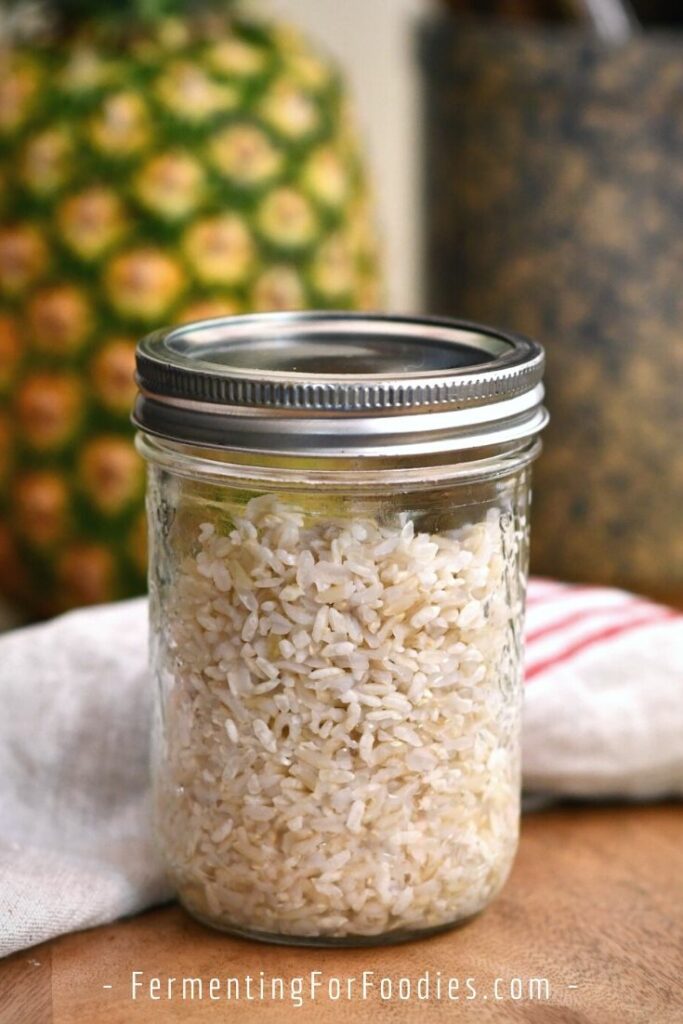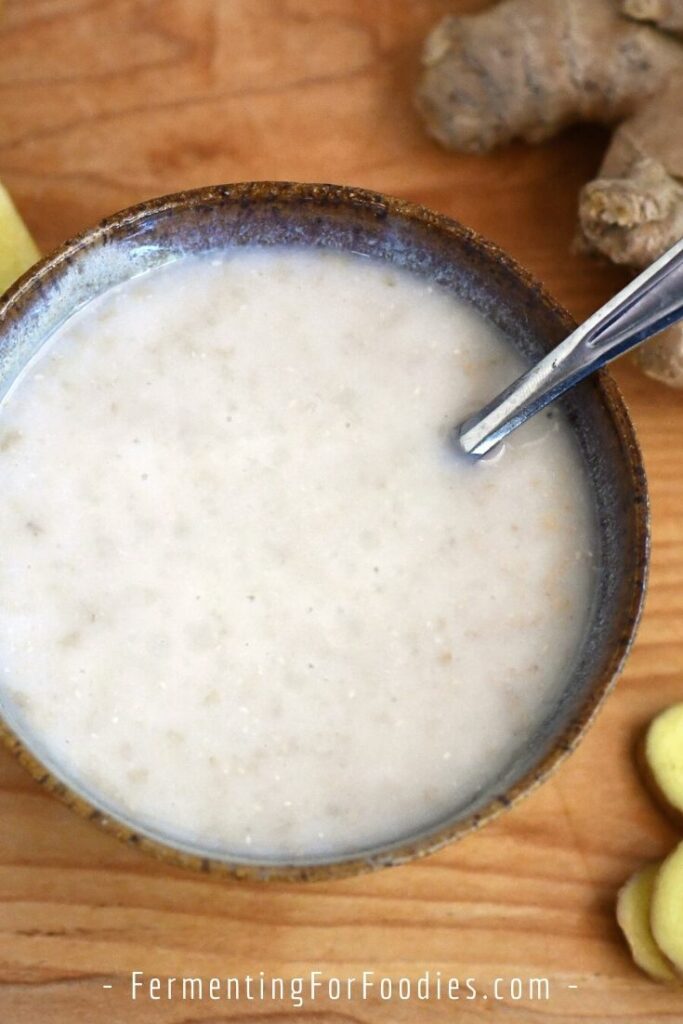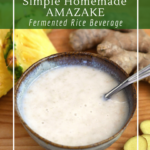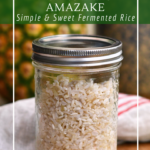Amazake is a sweet beverage made from koji rice. It is typically served as a warm drink flavored with fresh ginger. It can also be used as a natural sweetener or a vegan dairy alternative. Here’s how to make this simple rice drink.

What is Amazake?
Amazake is a traditional Japanese drink made from fermented rice called koji rice. Koji rice is rice that has had a particular strain of mold (koji kin) cultured on it. It is a really easy and reliable way to ferment, even for beginners. It’s why I LOVE koji ferments, including miso and shio koji.
In this recipe koji rice is used to breakdown the complex carbohydrates in rice to simple sugars. It happens at a temperature that’s a bit too warm for fermentation. It’s the enzymes in the koji rice that are doing to work of transforming rice. The result is a sweet and delicious beverage.
This process improves the nutritional value of rice and includes many nutrients. It is also good for gut health and digestion!
How to Serve Amazake
Homemade amazake has a sweet and toasty flavor. It is very versatile and can be used both as a beverage and for baking. Here are a few ways to use your koji amazake:
1. Warming Beverage
It is traditionally served as a warm spiced beverage. Here’s how to mix amazake into a warm beverage:
- Mix 1 part amazake with 1 part boiling water.
- Taste, and add more water if necessary.
- Served with a pinch of grated fresh ginger. (I also like to add a pinch of ground cinnamon).
2. Vegan Milk Substitute
Homemade amazake is a rich and delicious substitute for milk. Serve it for both hot and cold beverages or poured over a bowl of cereal.
To turn the rice paste into a vegan milk substitute, mix 1 part amazake with 2 parts water. Taste, and add more water, to taste.
3. As a sweetener for baking
Amazake is very similar to rice syrup. Since it is naturally sweet, it can replace sugar in the recipe. I’m pretty big into sugar-free baking, so I’ll admit these substitutions might not be as sweet as typical baking. However, the richness of the koji rice will improve your baking.
Here’s a few ways to use it for baking:
- Use it to replace liquid sweeteners.
- Add it as a substitute for milk, and reduce the amount of sugar.
4. Desserts!
Since it’s naturally sweet, it is perfect for dessert!
- To make my quinoa pudding recipe, using amazake instead! It’s delicious with vanilla, chocolate, or butterscotch flavors!
- Make a vegan chocolate banana ice cream, using amazake instead of coconut milk!
- Add it to smoothies or popsicles.

Homemade Amazake
Amazake is a sweet toasty beverage made from koji rice. It is delicious, served warm with fresh ginger, or used as a vegan dairy substitute. See the sections above for 4 different serving options.
- Prep Time: 10 minutes
- Cook Time: 15 minutes
- Total Time: 25 minutes
- Yield: 4 cups 1x
- Category: Beverages
- Cuisine: Japanese
- Diet: Vegan
Ingredients
- 1/2 cup rice (white or brown)
- 1 1/2 cups of water (for cooking
- 1/2 cup koji rice
- 1/2 cup water (chlorine-free, enough to cover)
Instructions
- Rinse the rice thoroughly before cooking to wash away the starch.
- Bring the rice and water to a boil. Reduce the heat and simmer, until soft. Drain off the excess water.
- Allow the rice to cool to around 130 F (60 C). Mix in koji rice. Then pack the rice mixture into a glass jar for fermentation. Cover with water (about 1/2 cup, as needed), then cap with a lid to keep the moisture. There’s no need to use a fermentation-specific lid as it won’t bubble. Incubate at 130 F (60 C) for up to 16 hours. See notes for advice on how to incubate.
- After fermenting, puree into a smooth paste. Store in the refrigerator until ready to use. It should last for 1 month in the fridge. Otherwise, freeze for long-term storage.
Notes
- Amazake is made at quite a hot temperature compared to yogurt and tempeh. The easiest way to maintain the right temperature is to use a rice cooker
or a slow cooker
set on warm.
- If you really get into fermenting, I recommend a Brød & Taylor Slow Cooker which I use for most of my ferments. My box only goes to 120 F, which isn’t ideal, but it’s still hot enough to make amazake.
- The nutritional profile of amazake depends on the temperature and length of time, so it isn’t possible to provide accurate information.



Both types of rices are cooked correct?
No, the koji rice will already have been cooked before culturing with the koji kin. It might be somewhat dry, but still cooked. So only the white rice needs to be cooked.
So just to clarify it is 1/2 cup of the already cooked koji rice and then 1/2 cup of dry rice which needs to be cooked to yield an even larger amount of cooked rice. Right?
Yes… 1/2 cup of koji + 1/2 cup of dried rice (about 1 1/2 cups cooked). Cheers!
Do you set the Brod & Taylor to slow cook mode and set temperature to 60 degress celcius? I have had two unsuccessful attempts at making amazake so far – ends of tasting sweet but somehow unpleasant. Quite different to the store bought amazeke we have tried.
Sorry to hear that it didn’t work out for you. I can set my Brod & Taylor to exactly 60C, so that’s what I use.
I’ve actually never tried store-bought amazake. I wonder if they sweeten it? I like it with ginger or cinnamon. Otherwise it just has a rice-like flavour. My other suggestion is to shorten the ferment to perhaps 8-12 hours? Hope that works!
your blog is quite appealing to me. Easy and straight forward explained.
Looking forward to try some of your Japanese fermentation recipes.
Many thanks
Sylvia
Thanks!
Hi, does it ferment naturally or do you need to add a microbial strain?
The culture comes from the koji rice, which has been inoculated with koji kin (a mold culture.)
Simple to prepare plus healthy…
Can an instant pot be used? Yogurt setting is probably only 90 F. Anyone used an instant pot to make the recipe!?
Sorry, I don’t have an instapot. However, it probably will work. Koji ferments tend to heat up as they ferment. If you try it let me know how it goes so I can share. Thanks!
Is the fermented rice counted as the same amount of carbs or does it not count as the fermented is assimilated differently in your body like fermented vegetables? I am new to this ferment thing, leaky gut pushing me into it and I’m actually kinda excited. But still working on understanding how it performs differently than regular carbs.
Welcome to fermenting! Fermenting grains (like rice) does breakdown the carbs. So they will be lower in carbs than regular grains… however, not sufficiently low in carbs to be considered “low carb”. And the amount of carbs depends on the type of ferment and how long it is fermented.
I pretty much always ferment grains. I’m GF and it improves the flavour, texture and digestibility. Amazake is quite sweet. The mold breaks down the complex carbs, giving it a sweet flavour. Be well, Emillie
I tried this with the bread proofer yesterday and woke up to two quarts of fresh amazake. Had it with turmeric, nutmeg, and cinnamon, and it was so good I drank a whole quart. 🙂 It also paired really well with French Roast coffee. Just for the hell of it, I used your recipe to ferment a super-grain porridge I made with amaranth, barley, oats, millet, and bulgar, which also turned out great. I imagine just oats would be great, as well–a new take on oatmeal. Thanks for your blog–it’s fantastic.
Wow, that sounds delicious! Thanks for sharing.
I hadn’t thought about it before, but using homemade amazake as a dairy substitute in baked goods is a great idea! One thing though: the temperatures used to bake would probably kill bacteria in the ferment, so any probiotic benefit would be lost.
You are right, like sourdough bread, using amazake for baking means that it will no longer be probiotic. However, it is delicious!
Hi there, thanks for this post! I am making Amazake right now and am finding that I can only put my brod and Taylor up to 60 C in the slow cooker mode…should I use the rack still or put my jar right on the element? What do you do? Thanks so much again!!
I use the rack, otherwise the bottom of the jar (in contact with the heating plate) will be too hot. Enjoy!
Okay thank you! So you put it to slow cooker mode, set it to 60, and use the rack? Or do you have the older model that doesn’t differentiate between proofer and slow cooker modes? Thanks so much again!
Loving your blog.
Is there a way to continue the fermenting so I don’t have to keep buying Koji?
I have a recipe for making koji rice again. I haven’t tried using amazake to make more amazake, but it could work. I’ll add it to my to-do list! Cheers, Emillie
Wow ! Super sweet for me so I guess more water, less amazake mix?
I used whole grain basmati rice which is nice and nutty. Nice blog!
Thanks! Definitely add in as much water as you want. It is quite sweet. 🙂 Basmati sounds delicious.
Hi Emillie,
Why do we need to add regular rice and not just use only koji rice alone? Thanks.
Good question! In this recipe, the enzymes from the koji rice are breaking down the white rice. It’s the white rice that gives amazake its flavor. You could do something similar with just koji rice, but you would have to use a lot of koji rice and it wouldn’t have the same flavor. Cheers!
Thank you so much Emilie for the reply!